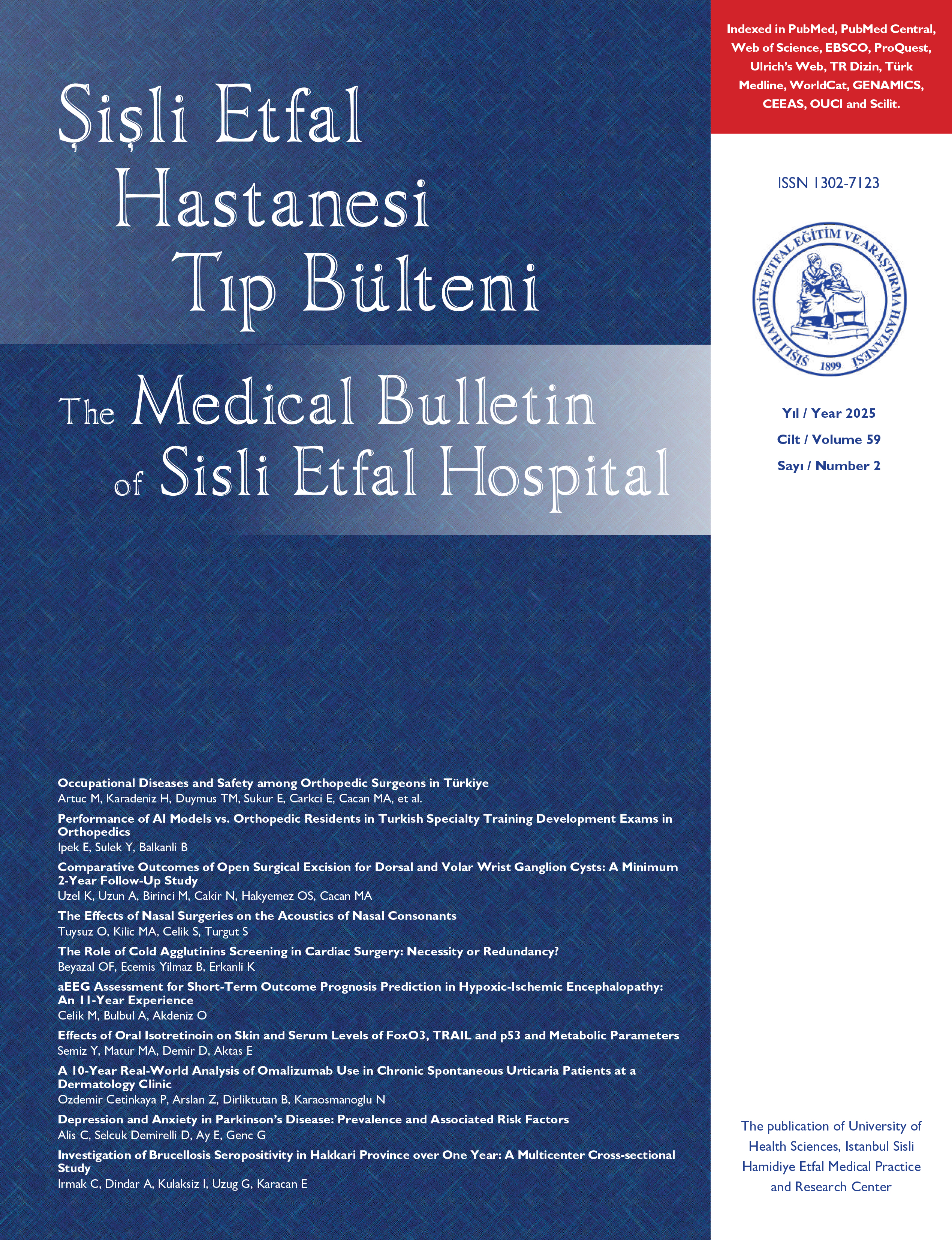
Doğumhanede yenidoğan bebeklerin izlem süreçleri: İki yıllık istatistiksel değerlendirme
Ali Bülbül, Lütfiye Şahin Keskin, Adil Umut Zübarioğlu, Hasan Sinan Uslu, Şehrinaz Demirel, Duygu Besnili Acar, Melek SelalmazSağlık Bilimleri Üniversitesi, Şişli Hamidiye Etfal Eğitim ve Araştırma Hastanesi, Yenidoğan Kliniği, İstanbul - TürkiyeAmaç: Hastanemizde doğan bebeklerin doğum sonrası izlem sonuçlarının epidemiyolojik açıdan incelenmesi.
Gereç ve Yöntem: Çalışmaya belirlenen iki yıl içerisinde (2014-2015 yılları) hastanemizde doğan tüm bebekler dahil edildi. Bebeklerin bilgileri, muayene bulguları, doğumhanede uygulanan girişimler, izlem sonuçları ve mevcut hastalıkları günlük olarak kaydedildi. Elde edilen veriler ülkemiz verileri ile karşılaştırıldı.
Bulgular: Belirlenen süre içerisinde 7172 gebelikten, 7175i (%99.02) canlı doğum ve 71i (%0.98) ölü doğum olmak üzere toplam 7246 bebek doğmuştu. Sezaryen ile doğum sıklığı %41.66, çoğul gebelik sıklığı %1.03 (n: 74), majör anomali sıklığı %0.77 (n: 55) olarak belirlendi. Gebelik süresine göre prematüre doğum (<37 hafta) %13.7 (n: 995), term doğum (38-42 hafta) %84.8 (n: 6143) ve postmatüredoğum (>42 hafta) %1,5 (n: 108) şeklindeydi. Bebeklerin doğum ağırlığına göre dağılımı: < 1000 gram %0.8 (n: 61), 1000-1500 gram %1.1 (n: 79), 1500 2500 gram %8.4 (n: 611), 2500-4000 gramı %84.5 (n: 6119) ve 4000 gram üstü %5.2 (n: 376) olduğu saptandı. Bebeklerde SGA oranı %6.7, AGA oranı %79.8 ve LGA oranı %13.5 idi. Bebeklerin %3.1inin yenidoğan ünitesinde takip edildiği, %8.2sini
yenidoğan yoğun bakım ünitesine yatırıldığı ve %1.4ünün başka hastanelere sevk edildiği belirlendi. Bebeklere doğumhanede %7.5 oranında oksijen verildiği, %2.4 oranında T parça canlandırıcı desteği verildiği ve %1.04 bebeğe entübasyon ve/veya göğüs kompresyonu uygulandığı belirlendi.
Sonuç: Ülkemizde yenidoğan bebeklerin doğumhanedeki kısa süreli izlemi ile ilgili yeterli çalışma bulunmamaktadır. Hastanemizde prematüre doğum oranları ve sezaryen doğum oranlarının ülkemiz değerlerinin altında ancak gelişmiş ülke değerlerinden yüksek olduğu belirlendi.
Follow up processes of newborn babies in delivery room: two-year statistical evaluation
Ali Bülbül, Lütfiye Şahin Keskin, Adil Umut Zübarioğlu, Hasan Sinan Uslu, Şehrinaz Demirel, Duygu Besnili Acar, Melek SelalmazSağlık Bilimleri Üniversitesi, Şişli Hamidiye Etfal Eğitim ve Araştırma Hastanesi, Yenidoğan Kliniği, İstanbul - TürkiyeObjective: Epidemiologic examination of the results of postnatal follow-up of infants born at our hospital.
Material and Method: All the babies born within two years (2014-2015) in our hospital were included in the study. Babies information, physical examination findings, interventions used in the delivery room, follow-up results and existing diseases were recorded daily. The obtained data were compared with the national data of our country.
Results: A total of 7246 newborns were born from 7172 pregnancies, 7175 (99.02%) live births and 71 (0.98%) stillbirths within the specified period. Rate of cesarean section, multiple pregnancy and major anomaly were 41.66%, 1.03% (n: 74) and 0.77% (n: 55) respectively. According to the gestational age, preterm delivery (<37 weeks) was 13.7% (n: 995), term delivery (38-42 weeks) was 84.8% (n: 6143) and postterm delivery (>42 weeks) was 1.5% (n: 108). Distribution of infants according to birth weight was determined as; <1000 grams 0.8% (n: 61), 1000-1500 grams 1.1% (n: 79), 1500-2500 grams 8.4% (n: 611), 2500-4000 84.5% (n: 6119) and > 4000 grams 5.2% (n: 376). The SGA rate in infants was 6.7%, the AGA rate was 79.8% and the LGA rate was 13.5%. It was found that 3.1% of babies were followed in newborn unit, 8.2% were admitted to neonatal intensive care unit and 1.4% were referred to other hospitals. In delivery room, babies were given oxygen at a rate of 7.5%, in 2.4% infants were used T-piece resuscitation support and 1.04% of babies were subjected to intubation and/or chest compression.
Conclusion: In our country, there are not enough studies about newborn babies short-term follow-up at delivery room. The preterm delivery rates and cesarean birth rates in our hospital were found to be below the country values but higher than the developed countries.
Makale Dili: Türkçe



















